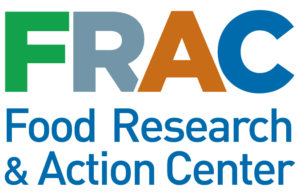
Clarissa Hayes, Senior Child Nutrition Policy Analyst, Food Action and Research Center (FRAC)
When the school bell rings to mark the beginning of summer break, millions of low-income children lose access to the school breakfasts and lunches they rely on during the school year. The federally funded Summer Nutrition Programs — the Summer Food Service Program (SFSP) and the National School Lunch Program (NSLP) — help to fill this hunger gap by providing funding so that programs can serve meals and snacks to children at sites in low-income areas.
Despite the important role the Summer Nutrition Programs play in helping families stretch their food budgets during the summer months, they remain underutilized. In July 2018, almost 2.9 million children participated on an average day, reaching only one child with a nutritious summer lunch through the Summer Nutrition Programs for every seven low-income children who participated in school lunch during the 2017–2018 school year.
Low-income children miss out on more than just meals when the Summer Nutrition Programs are not available to them. Summer meal sites frequently serve healthy meals alongside educational and enrichment programming, which together help combat summertime food insecurity, weight gain, and learning loss for children. Without access to the Summer Nutrition Programs, more children are at risk of returning to school further behind academically, which can have exponential ramifications on academic achievement year after year.
The Child Nutrition Reauthorization bill (CNR), currently being considered by Congress, provides an important opportunity to increase access to summer meals by ramping up investments in the Summer Nutrition Programs. CNR allows Congress to review the laws governing the child nutrition programs and make changes to strengthen and improve them. Several key proposals would increase the number of children served and eliminate barriers to participation. These include:
- allow SFSP sponsors to provide meals year-round, rather than operate SFSP in the summer and another program during the school year;
- lower the eligibility threshold from 50 to 40 percent so that more rural and suburban areas that often have substantial — but less concentrated — poverty can participate; and allow all meal sites to serve three meals.
To move the needle on summer meals, significant investments also must be made to support the summer programs that provide the platform for summer meal sites. This is because there simply are not enough affordable summer enrichment programs available for low-income families to participate in. Because these programs provide an important foundation for the Summer Nutrition Programs to operate, increased investments in summer programs at the federal, state, and local levels — combined with increased outreach, collaboration, and implementation of best practices — would ensure that low-income children would have access to the summer learning opportunities and the summer meals they need for a healthy summer and a strong start to the next school year.
Learn more about the Summer Nutrition Programs and how to support them in FRAC’s new report, Hunger Doesn’t Take a Vacation: Summer Nutrition Status Report.